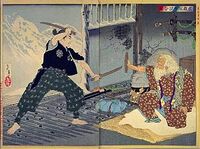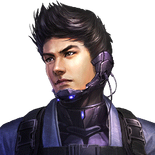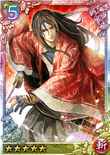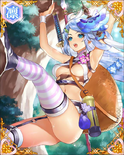| Bokuden Tsukahara | |
| Clan(s)/Alliance(s): | Tsukahara Kashima |
|---|---|
| Weapon Type: | Sword
|
| Unit Type: | Wise |
| First Appearance: | Samurai Warriors Chronicles 3 |
| Real name: | Tsukahara Bokuden
Tsukahara Takami |
| Japanese name: | 塚原卜伝
塚原高幹 |
| Born: | 1489
|
| Died: | February 11, 1571
|
Bokuden Tsukahara is one of the most famous swordsmen of the Sengoku era, famed for his unbeaten record, training many of the era's other famous swordsmen, and creating his own sword fighting style called Kashima Shintō-ryū.
The Nobunaga no Yabou 201X poll for 4-star officers puts him in twelfth place.
Role in Game[]
Samurai Warriors Chronicles 3 has Bokuden fight in the DLC map Swordplay Instructors, as one of the numerous sword masters in Masamune Date's coalition to challenge Munenori Yagyū's post as sword instructor for the Tokugawa Shogunate. Bokuden, alongside Masamune Date and Toshinao Kotouda begin the fight by rushing the ally main camp from three different locations, Bokuden from the south. Once defeated, Bokuden Tsukahara will continue to regularly respawn in the center, rushing towards the nearest officer until he can reach the main camp. He and several other sword saints will continue to respawn until Masamune is defeated again and the battle won. In Samurai Warriors 4: Empires, Bokuden appears as a ronin officer in the earlier stages, usually around the porvince he was born in.
Bokuden Tsukahara is an optional officer in Kessen III. He is first met as one of the few officers in the Shogunate army to actually be prepared for battle at the end of chapter 6. He hides in ambush near the main castle, attacking any forces that move across the outer wall. To convince him to change sides, Bokuden must be defeated in single combat during a rampage. Upon this defeat, he will be impressed by Nobunaga and seek to join him after the battle.
Quotes[]
- "Shall I teach you the art of war?"
- "Consider this part of your training."
- "Lets see how you like the taste of defeat!"
- "Now is our chance to seize the day!"
Fighting Style[]
Bokuden's abilities are squarely focused on leading katana units, although he is proficient in leading mounted and foot spearmen as well. Both his bonus in rampage as a warrior and his pre-equipped skills are focused on swiftly dishing out massive amounts of damage against enemy officers.
Historical Information[]
Tsukahara Bokuden was born to the Yoshikawa family in Hitachi province. His father was a priest for the shrine of Takemikazuchi and his family served the Kashima clan. His childhood name was Asako when Tsukahara Yasumoto lost his own son, he adopted Bokuden at the age of fourteen. His original family and his adopted family could trace their ancestry back to the imperial family and had close ties to the imperial house.
Both his birth father and adoptive father taught him the local sword fighting style of Tenshin Shōden Katori Shintō-Ryū, which Bokuden mastered by the age of seventeen. Wishing to improve his skills further, Bokuden decided to take up the swordsmen's journey of musha shugyo, a type of traveling/training noblemen engaged in, sometimes compared to the western idea of knight-errant.
Like those western counterparts, these wonderings of Tsukahara Bokuden produced stories that are hard to discern as to which contains the truth and which ones have been exaggerated. The most reliable source of information comes from the grandchild of one of Bokuden's students, Kato Nobutoshi. In this record, it claims that Bokuden engaged in at least nineteen separate duels and fought in up to 37 separate battles, where he claimed 21 heads of important warriors. This same record claims Tsukahara never suffered any sword wound in both duel or battle, but did suffer a few arrow wounds in his many skirmishes. His fame for such impressive fighting skills were only augmented by the numerous famous samurai he was reported to have trained. This impressive list includes Chōsokabe Nobuchika, Ashikaga Yoshiteru, Hosokawa Fujitaka, Kitabatake Tomonori, Yamamoto Kansuke, and Arakida Yoshishige.
During one of his trips home, Bokuden's adoptive father decided solidify his place as heir by arranging his daughter to marry Bokuden, solidifying his place as future clan leader. Bokuden thus had a permanent place he could return between his battles, wanderings, and time spent in meditation. Bokuden is believed to have spent some of his time training with Kamiizumi Nobutsuna, even fighting another duel to help Nobutsuna establish his own martial arts school.
As Bokuden continued to wander and train, he delevoped his own fighting style, which he called Kashima Shintō-Ryū. The exact nature of this style is lost to histroy. Tsukahara claimed Takemikazuchi (the deity his birth father served as a priest) gave the techique to him directly during a one thousand day stent meditating at the Kashima shrine. Although its unknown the exact nature of his style, it is thought to have incorporated a strategy of standing exposed, chest undefended from attack. When the foe was drawn in by this supposed opening, Bokuden would strike first, missing his foe's attack my mere inches. With this unique fighting style, Bokuden settled down and served his lord, establishing a school to train his pupils. In respect to his talent, Kashima Yoshimi, Tsukahara Bokuden's lord, allowed him to work full time at his school. Bokuden died at the age of 83 in 1571, passing on his school to his oldest son.
Japanese Folklore[]
The nature of Tsukahara Bokuden's wonderings mean most of his duels are shrowded in legend, making it hard to determine the historicity of these conflicts. Bokuden's skill and fame ensure many stories exist about other famous warriors wanting to test their mettle against Bokuden. While most of these duels could have happened, some of the more precise details are too hard to confirm.
One of Bokuden's first impressive feats during his time wondering was his duel with Ochiai Torazaemon. The duel took plae at Kyoto, in 1510. Torazaemon was twice Bokuden's age and showed little respect for Bokuden's challenge, spending his time before the duel ensuring they would have a sizable audience for Bokuden's shameful defeat. Torazaemon's overconfidence turned to shock during their duel, however, as Bokuden easily defeated him. Bokuden choose to leave Torazaemon alive after their short duel. Having suffered such humiliation, Torazaemon laid in ambush for Bokuden. Tsukahara reacted instantly, drawing his shorter blade, his Wakizashi, and mortally wounded his attacker. As Torazaemon died, he asked why Bokuen chose his shorter blade over the standard katana. Bokuden said he recognized the distance would be too cramped for his usual sword techiques.
Another famous man Bokuden dueled was Kajiwara Natago, who favored the Naginata as his weapon of choice. Natago was known for killing his opponents in harsh ways, trying to wound and leave his foes in agony. Bokuden recognized the weakness in this strategy combined with his weapon. The sword saint merely cut the bladed head off of the naginata during one of Natago's thrusts and proceeded to kill his now disarmed foe.
During Bokuden's stay with Kamiizumi Nobutsuna, a man named Shinamaru Enkai challenged Nobutsuna's burgeoning school and humiliated the students while Bokuden was away and Nobutsuna was sick. Bokuden decided to win their honor back by fighting Enkai's school in revenge. The story goes that Bokuden fought eighteen of Enkai's pupils before finally fightign and slaying Enkai himself in their duel.

Woodblock depicting Bokuden and Musashi's legendary duel
As Bokuden reached the latter days of his life, he began to turn his teaching from how to kill a foe quickly to how to avoid killing them at all. It was around this time his most famous duel took place. In this duel, an unruly swordsmen near Kyoto challenged Bokuden to a duel and would not accept no for an answer. Bokuden promised to defeat him with the No-Sword style, which the ruffian mocked. They agreed to duel on an island on lake Baiwa and crossed over to the island on the same boat. Bokuden let the man jump from the boat first and the lout rushed to shore to ensure he had the better footing. As he turned around to prepare to fight, Tsunahara simply rowed the boat back into open water and explained that this was how the no-sword style worked.
Although passing away over twelve years before his birth, a final, famous duel was often depicted in the legends surrounding Miyamoto Musashi. The fictional tale claims a young Mushashi approached Bokuden while he was boiling his tea, demanding a duel. Bokuden refused, which provoked Mushashi to attack. With no sword near by, Bokuden defended himself with his tea kettle lid, turning Mushashi's blade and pinning him to the ground.
Gallery[]
Gallery
|
|---|
100man-nin no Nobunaga no Yabou portrait Nobunaga no Yabou 201X portrait Bokuden Tsukahara in Samurai Cats
|








































